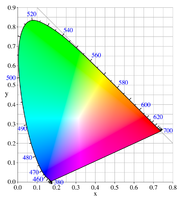
International Commission on Illumination
Encyclopedia

Light
Light or visible light is electromagnetic radiation that is visible to the human eye, and is responsible for the sense of sight. Visible light has wavelength in a range from about 380 nanometres to about 740 nm, with a frequency range of about 405 THz to 790 THz...
, illumination
Lighting
Lighting or illumination is the deliberate application of light to achieve some practical or aesthetic effect. Lighting includes the use of both artificial light sources such as lamps and light fixtures, as well as natural illumination by capturing daylight...
, color
Color
Color or colour is the visual perceptual property corresponding in humans to the categories called red, green, blue and others. Color derives from the spectrum of light interacting in the eye with the spectral sensitivities of the light receptors...
, and color space
Color space
A color model is an abstract mathematical model describing the way colors can be represented as tuples of numbers, typically as three or four values or color components...
s. It was established in 1913 as a successor to the Commission Internationale de Photométrie and is today based in Vienna, Austria
Vienna
Vienna is the capital and largest city of the Republic of Austria and one of the nine states of Austria. Vienna is Austria's primary city, with a population of about 1.723 million , and is by far the largest city in Austria, as well as its cultural, economic, and political centre...
.
Organization
The CIE has seven active divisions, each of which establishes technical committees to carry out its program under the supervision of the division's director:- Vision and Color
- Measurement of Light and Radiation
- Interior Environment and Lighting Design
- Lighting and Signalling for Transport
- Exterior Lighting and Other Applications
- Photobiology and Photochemistry
- General Aspects of Lighting (Inactive)
- Image Technology
Milestones
- In 1924 it established the standard photopic observer defined by the spectral luminous efficiency function V(λ), followed in 1951 by the standard scotopic observer defined by the function V’(λ).
- Building on the Optical Society of AmericaOptical Society of AmericaThe Optical Society is a scientific society dedicated to advancing the study of light—optics and photonics—in theory and application, by means of publishing, organizing conferences and exhibitions, partnership with industry, and education. The organization has members in more than 100 countries...
's report on colorimetryColorimetryColorimetry is "the science and technology used to quantify and describe physically the human color perception."It is similar to spectrophotometry, but is distinguished by its interest in reducing spectra to the physical correlates of color perception, most often the CIE 1931 XYZ color space...
in 1922, the CIE convened its eighth session in 1931, with the intention of establishing an international agreement on colorimetric specifications and updating the OSA's 1922 recommendations based on the developments during the past decade. The meeting, held in CambridgeCambridgeThe city of Cambridge is a university town and the administrative centre of the county of Cambridgeshire, England. It lies in East Anglia about north of London. Cambridge is at the heart of the high-technology centre known as Silicon Fen – a play on Silicon Valley and the fens surrounding the...
, United KingdomUnited KingdomThe United Kingdom of Great Britain and Northern IrelandIn the United Kingdom and Dependencies, other languages have been officially recognised as legitimate autochthonous languages under the European Charter for Regional or Minority Languages...
, concluded with the formalization of the CIE 1931 XYZ color spaceCIE 1931 color spaceIn the study of color perception, one of the first mathematically defined color spaces is the CIE 1931 XYZ color space, created by the International Commission on Illumination in 1931....
and definitions of the 1931 CIE 2° standard observer with the corresponding color matching functions, and standard illuminantStandard illuminantA standard illuminant is a theoretical source of visible light with a profile which is published. Standard illuminants provide a basis for comparing images or colors recorded under different lighting.-CIE illuminants:...
s A, B, and C.
- In 1964 the 10° CIE standard observer and its corresponding color matching functions as well as the new standard daylight illuminant D6500 were added, as well as a method for calculating daylight illuminants at correlated color temperatures other than 6500 kelvinKelvinThe kelvin is a unit of measurement for temperature. It is one of the seven base units in the International System of Units and is assigned the unit symbol K. The Kelvin scale is an absolute, thermodynamic temperature scale using as its null point absolute zero, the temperature at which all...
.
- In 1976, the commission developed the CIELAB and CIELUV color spaces, which are widely-used today.
- Based on CIELAB, color difference formulas CIEDE94 and CIEDE2000 were recommended in the corresponding years.
See also
- International Color ConsortiumInternational Color ConsortiumThe International Color Consortium was formed in 1993 by eight industry vendors in order to create a universal color management system that would function transparently across all operating systems and software packages....
- International Colour AssociationInternational Colour AssociationThe International Colour Association is a learned society whose aims are to encourage research in all aspects of color, to disseminate the knowledge gained from this research, and to promote its application to the solution of problems in the fields of science, art, design and industry on...
- International Electrotechnical CommissionInternational Electrotechnical CommissionThe International Electrotechnical Commission is a non-profit, non-governmental international standards organization that prepares and publishes International Standards for all electrical, electronic and related technologies – collectively known as "electrotechnology"...
- International Organization for StandardizationInternational Organization for StandardizationThe International Organization for Standardization , widely known as ISO, is an international standard-setting body composed of representatives from various national standards organizations. Founded on February 23, 1947, the organization promulgates worldwide proprietary, industrial and commercial...

